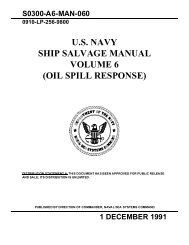U.S. NAVY SALVAGE REPORT DEEPWATER HORIZON ... - ESSM
U.S. NAVY SALVAGE REPORT DEEPWATER HORIZON ... - ESSM
U.S. NAVY SALVAGE REPORT DEEPWATER HORIZON ... - ESSM
You also want an ePaper? Increase the reach of your titles
YUMPU automatically turns print PDFs into web optimized ePapers that Google loves.
Deepwater Horizon Oil Spill Response<br />
6/28/2010 SITREP<br />
Admiral,<br />
The attached drawing depicts the next phase of BP's MC252 well containment and disposal plan (CDP). I will discuss<br />
the principle aspects of this plan as shown in the drawing.<br />
Current situation:<br />
1. Discoverer Enterprise is producing 15-18 M BOPD (thousands of barrels of oil per day) and 30-40 MM SCFPD<br />
(millions of standard cubic feet of gas per day) via LMRP cap #4, installed above the cut MC252 marine riser.<br />
2. Q4000 is flaring 6-8 M BOPD and 18-19 MM SCFPD via, in series; the MC252 kill line, a flexible jumper to a<br />
manifold on the seabed (the old dynamic kill manifold), a flexible jumper to a riser termination package, the Q4000<br />
drill string inside the Q4000 marine riser.<br />
The short term goal is to increase product capture to the point where the LMRP cap can be removed and a<br />
combination BOP stack/valve manifold installed onto the MC252 LMRP. This would allow complete capture of all<br />
product w/o the risk of over-pressurizing the well bore and releasing product into the adjacent subsea formation, and<br />
subsequently the water column. Before the well can be completely capped (vice the partial cap that is currently<br />
installed w/four vent valves releasing product into the sea) additional product must be captured to eliminate the risk of<br />
over-pressurization.<br />
Short term plan to capture additional product:<br />
1. The MC252 choke line is already connected to the old dynamic kill manifold with a flexible jumper. Jumpers will<br />
now be connected in series from this manifold to a new manifold (CDP Manifold in the drawing) and from there to a<br />
free standing marine riser (Free Standing Riser #1 in the drawing). The CDP manifold is on the seabed and Free<br />
Standing Riser #1 has been installed. Unfortunately, the jumper installation has not gone well (missing gaskets,<br />
crimped goosenecks) and as of tonight, only one of the four required connections has been made.<br />
2. A transfer line will be installed on top of Free Standing Riser #1 and connected to a buoy that can be pulled into a<br />
production vessel, securely latched into that vessel and then used to transfer product from the riser to the vessel.<br />
This is existing Floating Production Storage and Offloading (FPSO) technology. Once these connections have been<br />
made, and appropriate valve alignments on the manifolds completed, product can flow from the MC252 choke line,<br />
through the jumpers and two manifolds, into free standing riser #1, through the transfer line, into the buoy and then<br />
into the production vessel. In the drawing, this vessel is listed as Toisa Pisces. However there has been a change<br />
and production vessel Helix Producer (HP) will be used instead of Toisa Pisces. Tanker Loch Rannoch will be used to<br />
lighter product from HP once HP's tanks are full.<br />
This system will allow capture of 20-25 M BOPD, enough to initiate the next phase in BP's plan, removing LMRP cap<br />
#4 and attaching a BOP stack/valve manifold to the MC252 LMRP. I will not discuss subsequent phases of the overall<br />
plan in detail in this report b/c multiple options are being studied and the short term work is not yet complete.<br />
Short term prognosis:<br />
Jumper installation will probably not be completed on night shift tonight. The seas are making up and I expect that all<br />
subsea installation work will be put on hold tomorrow until the weather improves. Estimate for re-initiation of subsea<br />
work based on current track of TS Alex is Saturday 7/3.<br />
Figure 5-19. Sample SITREP from ICP Houston.<br />
3. Lastly, NAVSEA 00 needed someone who was familiar with the activities in Houston to<br />
be able to respond to questions about the operation and suggestions for employing Navy<br />
assets. Questions ranged from those generated by U.S. Congressional staff to those<br />
asked by the Chairman of the Joint Chiefs of Staff. COMNAVSEA would typically forward<br />
them to SUPSALV for generating the response. Suggestions ran the full gamut from<br />
thoughtful and potentially useful to off the wall. Because many of these suggestions were<br />
not practical or would actually be detrimental to the effort, COMNAVSEA needed<br />
someone who could speak with authority on the pros and cons of those suggestions.<br />
The range of suggestions encountered included sending the SEALs in to stop the leak or<br />
to send a nuclear tipped torpedo down the well. A typical response to one of these<br />
suggestions would include the words “We have drawn on the insight and expertise of<br />
NAVSEA engineers (embedded for over a month with the crisis engineering team in<br />
Houston, TX) The proposed concept for this innovative suggestion is…”, “However,<br />
there is no current short-fall in that capability.”<br />
5-23

















